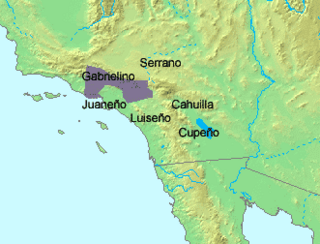| Tongva | |
|---|---|
| Gabrielino, Gabrieleño | |
| eyooshiraaw | |
| Native to | Southern California, United States |
| Region | Los Angeles, Santa Catalina Island |
| Ethnicity | Tongva |
| Extinct | ca. 1900 |
| Revival | since 2000s |
| Language codes | |
| ISO 639-3 | xgf |
xgf | |
| Glottolog | tong1329 |
 | |
The Tongva language (also known as Gabrielino or Gabrieleño) is an extinct[1] Uto-Aztecan language formerly spoken by the Tongva, a Native American people who have lived in and around modern day Los Angeles for centuries. It has not been a language of everyday conversation since the 1940s. The Gabrielino people now speak English but a few are attempting to revive their language by using it in everyday conversation and ceremonial contexts. Presently, Gabrielino is also being used in language revitalization classes and in some public discussion regarding religious and environmental issues.[2] Tongva is closely related to Serrano.[3] The names of several cities and neighborhoods in Southern California are of Tongva origin, and include Pacoima, Tujunga, Topanga, Azusa, Cahuenga in Cahuenga Pass and Cucamonga in Rancho Cucamonga.
The last fluent native speakers of Tongva lived in the early 20th century. The language is primarily documented in the unpublished field notes of John Peabody Harrington made during that time. The "J.P. Harrington Project", developed by The Smithsonian through University of California, Davis, approximately 6,000 pages of his notes on the Tongva language, were coded for documentation by a Tongva member, who took three years to accomplish the task. Alleged native speakers of Tongva who have died as late as in the 1970s have not been verified as having been fluent speakers.
The minor planet 50000 Quaoar was named after the Tongva creator god.[4]
- ^ Glottolog 4.4 – Tongva
- ^ Fortier, Jana (December 2008). Native American Consultation And Ethnographic Study, Ventura County, California (Report). La Jolla, California: California Department of Transportation. pp. 13–14. Retrieved June 17, 2019.
- ^ Golla, Victor (2011). California Indian Languages. University of California Press. ISBN 978-0-520-26667-4.
- ^ Byrd, Deborah (February 19, 2013). "Quaoar, a rocky world orbiting beyond Neptune". EarthSky. Retrieved August 31, 2014.